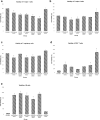Conditioned media of pancreatic cancer cells and pancreatic stellate cells induce myeloid-derived suppressor cells differentiation and lymphocytes suppression
- PMID: 35853996
- PMCID: PMC9296552
- DOI: 10.1038/s41598-022-16671-9
Conditioned media of pancreatic cancer cells and pancreatic stellate cells induce myeloid-derived suppressor cells differentiation and lymphocytes suppression
Erratum in
-
Author Correction: Conditioned media of pancreatic cancer cells and pancreatic stellate cells induce myeloid-derived suppressor cells differentiation and lymphocytes suppression.Sci Rep. 2023 Aug 10;13(1):13040. doi: 10.1038/s41598-023-40226-1. Sci Rep. 2023. PMID: 37563191 Free PMC article. No abstract available.
Abstract
As pancreatic cancer cells (PCCs) and pancreatic stellate cells (PSCs) are the two major cell types that comprise the immunosuppressive tumor microenvironment of pancreatic cancer, we aimed to investigate the role of conditioned medium derived from PCCs and PSCs co-culture on the viability of lymphocytes. The conditioned medium (CM) collected from PCCs and/or PSCs was used to treat peripheral blood mononuclear cells (PBMCs) to determine CM ability in reducing lymphocytes population. A proteomic analysis has been done on the CM to investigate the differentially expressed protein (DEP) expressed by two PCC lines established from different stages of tumor. Subsequently, we investigated if the reduction of lymphocytes was directly caused by CM or indirectly via CM-induced MDSCs. This was achieved by isolating lymphocyte subtypes and treating them with CM and CM-induced MDSCs. Both PCCs and PSCs were important in suppressing lymphocytes, and the PCCs derived from a metastatic tumor appeared to have a stronger suppressive effect than the PCCs derived from a primary tumor. According to the proteomic profiles of CM, 416 secreted proteins were detected, and 13 DEPs were identified between PANC10.05 and SW1990. However, CM was found unable to reduce lymphocytes viability through a direct pathway. In contrast, CM that contains proteins secreted by PCC and/or PSC appear immunogenic as they increase the viability of lymphocytes subtypes. Lymphocyte subtype treated with CM-induced MDSCs showed reduced viability in T helper 1 (Th1), T helper 2 (Th2), and T regulatory (Treg) cells, but not in CD8+ T cells, and B cells. As a conclusion, the interplay between PCCs and PSCs is important as their co-culture displays a different trend in lymphocytes suppression, hence, their co-culture should be included in future studies to better mimic the tumor microenvironment.
© 2022. The Author(s).
Conflict of interest statement
The authors declare no competing interests.
Figures







References
-
- Stark, A. & Eibl, G. Pancreatic Ductal Adenocarcinoma. Pancreapedia: Exocrine Pancreas Knowledge Base (2017).
Publication types
MeSH terms
Substances
LinkOut - more resources
Full Text Sources
Medical
Research Materials

